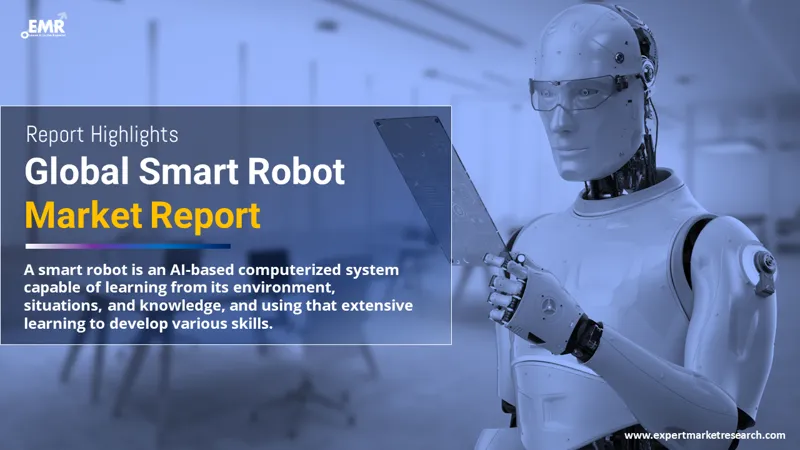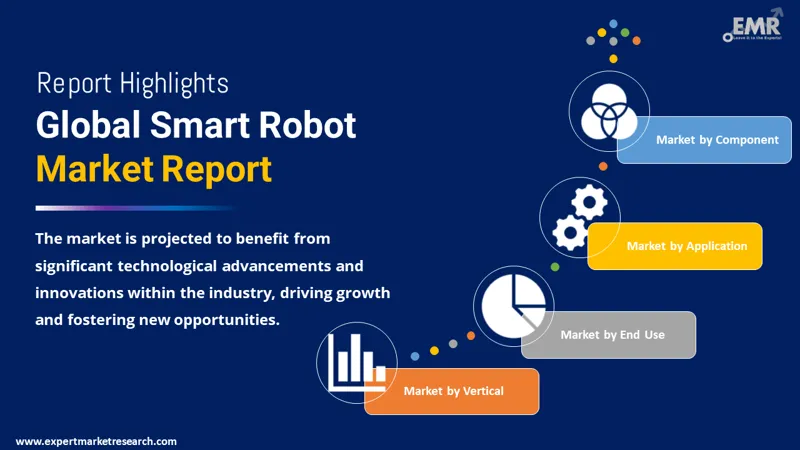
Consumer Insights
Uncover trends and behaviors shaping consumer choices today
Procurement Insights
Optimize your sourcing strategy with key market data
Industry Stats
Stay ahead with the latest trends and market analysis.
Trending Now



The global smart robot market was valued at USD 12.10 Billion in 2024 and is anticipated to expand at a CAGR of 27.20% during the forecast period of 2025 to 2034. The market is further expected to reach a value of nearly USD 134.17 Billion by 2034. Key factors driving the smart robot market are labor shortages, needs for increased operational efficiency in industries like manufacturing, healthcare, and logistics, and the further development of AI.
Base Year
Historical Year
Forecast Year






Value in USD Billion
2025-2034
Smart Robot Market Outlook
*this image is indicative*

Read more about this report - REQUEST FREE SAMPLE COPY IN PDF
The smart robot market is growing rapidly, spurred by AI, IoT, and machine learning. Key sectors are manufacturing, healthcare, retail, and logistics, as robots are applied for automation, precision tasks, and customer engagement. Such sectoral demand has been boosting the growth of smart robot market.
Trends in human-robot collaboration, adoption of autonomous mobile robots (AMRs), robots for elderly care and rehabilitation, and vision systems, natural language processing, etc., are being developed for the improvement of robot capabilities. Drivers include rising labor costs and concerns for efficiency and safety. Challenges include high costs, cybersecurity risks, and technical complexities. Emerging markets and service robotics are considered attractive growth opportunities.
The demand for smart robots in surgery, rehabilitation, and patient care is driven by the need for automation in the healthcare sector. For instance, Intuitive Surgical's da Vinci robotic system has transformed minimally invasive surgeries through precision and remote operation. Moxi, developed by Diligent Robotics, helps hospital staff with supply delivery, reduces workload, and improves patient care. As healthcare providers strive for efficiency and better patient outcomes, the use of smart robots in medical environments is growing.
The rising need for robots in warehouses for logistics management and delivery to enhance productivity by eliminating mundane tasks is pushing the growth of smart robot market. In addition to this, the boom of e-commerce has laid emphasis on uninterrupted efficiency in tasks like sorting, especially in parcel operations, due to the diversity in the product line. Smart robots equipped with advanced digital technology like IoT and artificial intelligence (AI) add to the productivity by speeding up the process, reducing human errors, and improving accuracy, thereby aiding the market growth. Moreover, professional robots have gained significant popularity as a result of COVID-19, where these robots are increasingly used for building disinfection and minimising human intervention by reducing the risk of infection.
The agricultural sector is slwoly becoming more dependent on smart robots for tasks such as planting, harvesting, and crop monitoring. For example, Blue River Technology's See & Spray, which uses AI-powered robots that target weeds without the usage of chemicals. Another example includes Agrobot's robotic strawberry harvester, which facilitates delicate fruit picking. It is with this growing recognition of sustainable farming practices and the increase in productivity, reduced impact on the environment, and labor shortages that propel agricultural robotics forward.
Cobots, healthcare robots, AMRs, and customer-focused robots transform industries with automation and AI.
Cobots, or collaborative robots, have been increasingly used in manufacturing and logistics for precision work and safety with humans. For instance, Universal Robots has cobots that assist in packaging, assembly, and quality inspection, reducing repetitive tasks that workers have to perform. They are lightweight, adaptable, and safe, making it easier for small and medium enterprises to automate processes at a reduced cost. The trend is driven by the demand for increased productivity and flexibility in industries without completely replacing human labor, pushing the smart robot demand.
Intelligent robots in healthcare revolutionize patient care and precision in surgery. For example, Intuitive Surgical's da Vinci system allows performing of minimally invasive surgeries by achieving robotic precision for better outcome and recovery times. There is also the care of old-age patients and rehabilitation, through for example SoftBank's Pepper, which is providing friendship and basic health monitoring among many others. An increase in elderly and the advancement in AI gives room for this.
AMRs are transforming warehouse and logistics operations by optimizing the movement of inventory and reducing operational costs. For instance, Amazon Robotics uses AMRs to streamline picking and sorting processes in fulfillment centers. Unlike AGVs, AMRs use AI to navigate complex environments autonomously, offering flexibility in dynamic settings. This trend addresses growing e-commerce demands and labor shortages in logistics, thus boosting the smart robot market revenue.
Service robots are being applied extensively for customer engagement in retail, hospitality, and banking services. For instance, LG's CLOi robots in stores and hotels navigate the customers, answer queries, and make transactions. AI and natural language processing enable these robots to present customized experiences that build the satisfaction of customers. It has been fueled by innovative services contactless after the pandemic and increasing expectations by customers for tech-driven engagements.
The expanding integration of IoT in robots for cost-effective predictive maintenance is driving the growth of the market. Predictive maintenance is the process of predicting possible problems before they occur. An IoT- based system enables the storage of terabytes of data and the parallel execution of machine learning (ML) algorithms on multiple computers to detect possible risks and notify the user when the industrial equipment is likely to cause problems, thereby assisting in predictive maintenance and pushing the smart robot market growth.
An example to support this is the collaboration between IBM and the city of Munich that utilizes IoT and AI for predictive maintenance to optimize waste management. The system is designed to identify when the trash bins are full and predict maintenance needs, making the process more efficient and less costly.
Digital networking of multiple equipment, robots, and systems is used to construct integrated smart processes using the internet of things (IoT) technology and the growing market penetration of the technology aided by robust internet facilities are opening up new smart robot market opportunities. Data from various sensors in a robot, such as heat and voltage, is collected on the cloud and evaluated using machine learning (ML) algorithms. Thus, the incorporation of advanced digital technology is providing impetus to the market.
A key technology propelling the smart robot market forward is artificial intelligence, particularly in machine learning and deep learning, thus bolstering the smart robot market dynamics and trends. These technologies allow for adaptation, learning from the environment, and improvement over time in robots. AI systems allow robots to perform complex tasks such as autonomous navigation, object recognition, and decision-making. For example, the manufacturing industry uses AI-powered robots in predictive maintenance, thereby increasing efficiency in anticipation of equipment failure before it happens. AI in robots is still on the rise, enhancing their functionality and market demand.

Read more about this report - REQUEST FREE SAMPLE COPY IN PDF
“Smart Robot Market Report and Forecast 2025-2034” offers a detailed analysis of the market based on the following segments:
The market can be broadly categorised on the basis of its component into:
On the basis of its application, the market can be divided into:
The market, based on end use, can be segmented into:
Categorisation on the basis of vertical includes:
Market Breakup by Region
By Component Analysis
As per smart robot market analysis, advances in AI and automation are giving smart robots an edge in hardware, software, and services. Developments in sensors, actuators, and processors in hardware enable increased precision and efficiency. Software growth can be attributed to the advancement of AI, machine learning, and data analytics, which improve the abilities of the robots. With companies offering integration, maintenance, and support, services are increasing, leading to the use of automation in manufacturing, healthcare, and logistics sectors.
Market Analysis by Application
Smart robots are finding increasing applications in industries such as manufacturing and logistics due to automation, increased efficiency, and labor cost savings. AI-powered service robots enhance customer experiences in healthcare, retail, and hospitality sectors. Robots improve precision, speed, and operational safety while overcoming labor shortages. The integration of IoT and AI in robots makes them versatile, autonomous, and economical, thus supporting market growth.
End Use Insights
As per smart robot industry analysis, advancements in automation and the integration of IoT have seen smart robots take over industries, commercial ventures, and even homes. In the industries, smart robots facilitate process streamlining, boost productivity, and cut on labor costs. In the commercial industry, they enhance service delivery with better customer experience. The domestic smart robots concentrate on automating homes and doing various chores, and with convenience, there is increasing uptake. It goes along with the increase in the demand for efficiency and smart solutions in many fields.
By Vertical Analysis
Smart robots are gaining acceptance in multiple verticals by increasing efficiency and automation. In the automotive world, robots are increasingly used on assembly lines for precise operations. In healthcare, they assist in surgery and patient care for better outcomes. In manufacturing, it reduces human error, and in food and beverage, they ensure packaging and delivery with fewer hassles. In retail, they help manage inventory, while energy and utilities gain by having maintenance and monitoring through automation.
North America Smart Robot Market Opportunities
The United States market for smart robots seeks to strengthen its manufacturing base in the context of increased automation, which would impact economic growth and national security. Investments are made in leading-edge robotics, including collaborative robots that enhance productivity within key sectors such as aerospace and automotive. Robotics is used to overcome challenges in the defense sector to ensure operational readiness and supply chain resilience.
Asia Pacific Smart Robot Market Trends
Asia Pacific is experiencing tremendous demand for industrial robots due to rapid manufacturing automation. The leader in robot deployment in the region, China, focuses on improving production efficiency and is moving towards Industry 4.0. The growth of e-commerce and smart factories is driving the adoption of AI-powered robots in manufacturing.
Europe Smart Robot Market Dynamics
In Europe smart robots market, these robots are considered an essential part of sustainable manufacturing growth. Germany and France are taking a lead in advancing their industrial automation with flexible and efficient robots. The European Union is investing in initiatives to strengthen robotics R&D and promote their deployment in manufacturing.
Middle East and Africa Smart Robot Market Drivers
The Middle East is speeding up its robotics adoption due to the rapid advancement of AI and IoT. The UAE, for example, is investing heavily in automation technologies across sectors such as logistics, healthcare, and manufacturing in order to improve productivity and competitiveness.
Latin America Smart Robot Market Insights
Latin America is where countries such as Brazil adopt robots in sectors like agriculture and manufacturing. Robotics development has emerged as a focal point for innovation with significant investments focused on enhancing industrial capabilities and catering to the growing demands of markets.
Smart robot market players have emphasized the need to build greater AI capacity, industrialize automation in various industries, and make human-robot interaction easier. The major smart robot companies include Boston Dynamics, ABB, and iRobot: more precision, flexibility, and mobility of robots are being engineered for industrial purposes, logistics, and consumers. Also, IoT is being incorporated into the devices for intelligent decision-making processes, as well as energy efficiency for a reduced cost and extended deployment over a period of time.
ABB Ltd., originally founded in 1988 and located in Switzerland, includes industrial robots like the YuMi collaborative robot, whose purpose is to execute assembling tasks, providing high precision and flexibility when it comes to automation.
iRobot Corporation was formed in 1990 and had its headquarters in the United States of America. This firm is recognized for its consumer products, specifically the Roomba vacuum cleaning robot. In this company, it combines AI and sensors for automated home cleaning.
Fanuc Corporation, founded in 1956 and headquartered in Japan, is an industrial robot manufacturer of M-20iA and others that are designed for high-speed, precision tasks across various industries, including automotive and electronics.
Yaskawa Electric Corporation, founded in 1915 and headquartered in Japan, produces the Motoman series of robots used in industrial automation, such as welding, assembly, and material handling, to enhance productivity and accuracy.
*Please note that this is only a partial list; the complete list of key players is available in the full report. Additionally, the list of key players can be customized to better suit your needs.*
Other smart robot market players include Kuka AG, among others.
Smart robot startups seek to transform industries through the improvement of automation, precision, and efficiency with AI-driven robotics. They seek to address labor shortages, optimize workflows, and innovate healthcare, manufacturing, logistics, and customer service. Affordable and adaptable, these startups ensure wide adoption of robots and advancements in human-robot collaboration, autonomous systems, and intelligent decision-making.
Covariant
Covariant focuses on creating warehouse-picking and sorting AI-enabled robots. Their adaptable system enhances efficiency in logistics, e-commerce, and supply chains by learning and improving overtime.
Diligent Robotics
Diligent Robotics will build healthcare robots like "Moxi," which can perform activities like delivering supplies to help medical staff focus more on patients.
*While we strive to always give you current and accurate information, the numbers depicted on the website are indicative and may differ from the actual numbers in the main report. At Expert Market Research, we aim to bring you the latest insights and trends in the market. Using our analyses and forecasts, stakeholders can understand the market dynamics, navigate challenges, and capitalize on opportunities to make data-driven strategic decisions.*
Get in touch with us for a customized solution tailored to your unique requirements and save upto 35%!
In 2024, the market reached an approximate volume of 12.10 Billion.
The smart robot industry is assessed to grow at a CAGR of 27.20% between 2025 and 2034.
The market is estimated to witness healthy growth in the forecast period of 2025-2034 to reach around 134.17 Billion by 2034.
The expanding integration of IoT in robots for cost-effective predictive maintenance, logistics automation, and healthcare sector is booming the growth of the market.
The market is expected to be aided by the technological innovation in the industry.
The major regions in the industry are North America, Latin America, the Middle East and Africa, Europe, and the Asia Pacific.
The different types of smart robots in the industry are hardware, software, and services.
The various applications of smart robot are industrial robots and service robots.
The major end uses of smart robot are industrial, commercial, and residential.
The significant verticals in the market are automotive, healthcare, manufacturing, food and beverages, retail, energy and utility, among others.
The major players in the industry are ABB Ltd., iRobot Corporation, Fanuc Corporation, Yaskawa Electric Corporation, and Kuka AG, among others.
Explore our key highlights of the report and gain a concise overview of key findings, trends, and actionable insights that will empower your strategic decisions.
| REPORT FEATURES | DETAILS |
| Base Year | 2024 |
| Historical Period | 2018-2024 |
| Forecast Period | 2025-2034 |
| Scope of the Report |
Historical and Forecast Trends, Industry Drivers and Constraints, Historical and Forecast Market Analysis by Segment:
|
| Breakup by Component |
|
| Breakup by Application |
|
| Breakup by End Use |
|
| Breakup by Vertical |
|
| Breakup by Region |
|
| Market Dynamics |
|
| Competitive Landscape |
|
| Companies Covered |
|
| Report Price and Purchase Option | Explore our purchase options that are best suited to your resources and industry needs. |
| Delivery Format | Delivered as an attached PDF and Excel through email, with an option of receiving an editable PPT, according to the purchase option. |
Datasheet
One User
USD 2,499
USD 2,249
tax inclusive*
Single User License
One User
USD 3,999
USD 3,599
tax inclusive*
Five User License
Five User
USD 4,999
USD 4,249
tax inclusive*
Corporate License
Unlimited Users
USD 5,999
USD 5,099
tax inclusive*
*Please note that the prices mentioned below are starting prices for each bundle type. Kindly contact our team for further details.*
Flash Bundle
Small Business Bundle
Growth Bundle
Enterprise Bundle
*Please note that the prices mentioned below are starting prices for each bundle type. Kindly contact our team for further details.*
Flash Bundle
Number of Reports: 3
20%
tax inclusive*
Small Business Bundle
Number of Reports: 5
25%
tax inclusive*
Growth Bundle
Number of Reports: 8
30%
tax inclusive*
Enterprise Bundle
Number of Reports: 10
35%
tax inclusive*
How To Order
Our step-by-step guide will help you select, purchase, and access your reports swiftly, ensuring you get the information that drives your decisions, right when you need it.

Select License Type
Choose the right license for your needs and access rights.

Click on ‘Buy Now’
Add the report to your cart with one click and proceed to register.

Select Mode of Payment
Choose a payment option for a secure checkout. You will be redirected accordingly.
Gain insights to stay ahead and seize opportunities.

Get insights & trends for a competitive edge.

Track prices with detailed trend reports.

Analyse trade data for supply chain insights.

Leverage cost reports for smart savings

Enhance supply chain with partnerships.

Connect For More Information
Our expert team of analysts will offer full support and resolve any queries regarding the report, before and after the purchase.
Our expert team of analysts will offer full support and resolve any queries regarding the report, before and after the purchase.
We employ meticulous research methods, blending advanced analytics and expert insights to deliver accurate, actionable industry intelligence, staying ahead of competitors.
Our skilled analysts offer unparalleled competitive advantage with detailed insights on current and emerging markets, ensuring your strategic edge.
We offer an in-depth yet simplified presentation of industry insights and analysis to meet your specific requirements effectively.



Australia
63 Fiona Drive, Tamworth, NSW
+61-448-061-727
India
C130 Sector 2 Noida, Uttar Pradesh 201301
+91-723-689-1189
Philippines
40th Floor, PBCom Tower, 6795 Ayala Avenue Cor V.A Rufino St. Makati City,1226.
+63-287-899-028, +63-967-048-3306
United Kingdom
6 Gardner Place, Becketts Close, Feltham TW14 0BX, Greater London
+44-753-713-2163
United States
30 North Gould Street, Sheridan, WY 82801
+1-415-325-5166
Vietnam
193/26/4 St.no.6, Ward Binh Hung Hoa, Binh Tan District, Ho Chi Minh City
+84-865-399-124
United States (Head Office)
30 North Gould Street, Sheridan, WY 82801
+1-415-325-5166
Australia
63 Fiona Drive, Tamworth, NSW
+61-448-061-727
India
C130 Sector 2 Noida, Uttar Pradesh 201301
+91-723-689-1189
Philippines
40th Floor, PBCom Tower, 6795 Ayala Avenue Cor V.A Rufino St. Makati City, 1226.
+63-287-899-028, +63-967-048-3306
United Kingdom
6 Gardner Place, Becketts Close, Feltham TW14 0BX, Greater London
+44-753-713-2163
Vietnam
193/26/4 St.no.6, Ward Binh Hung Hoa, Binh Tan District, Ho Chi Minh City
+84-865-399-124
Share